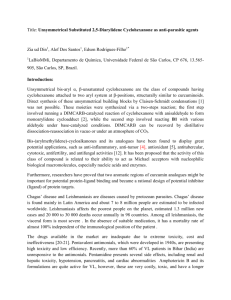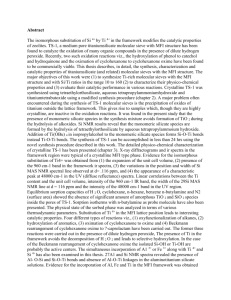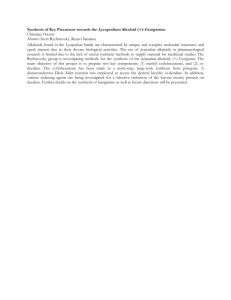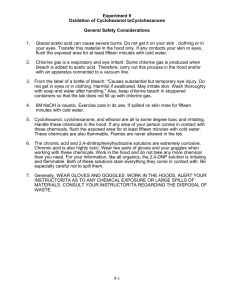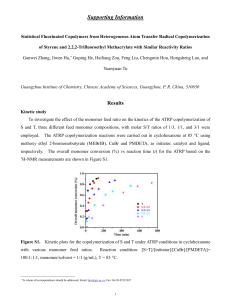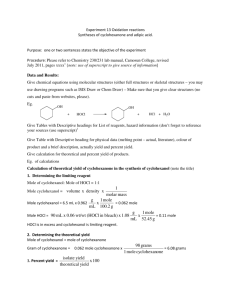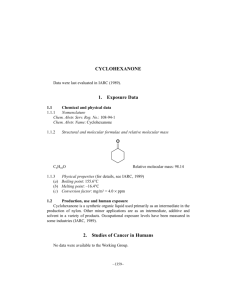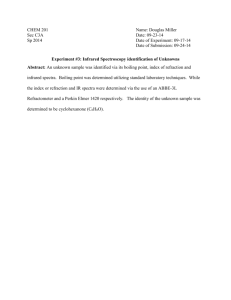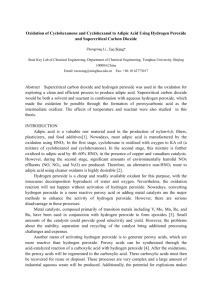A Rationale of the Baeyer Villiger Oxidation of Cyclohexanone to
advertisement
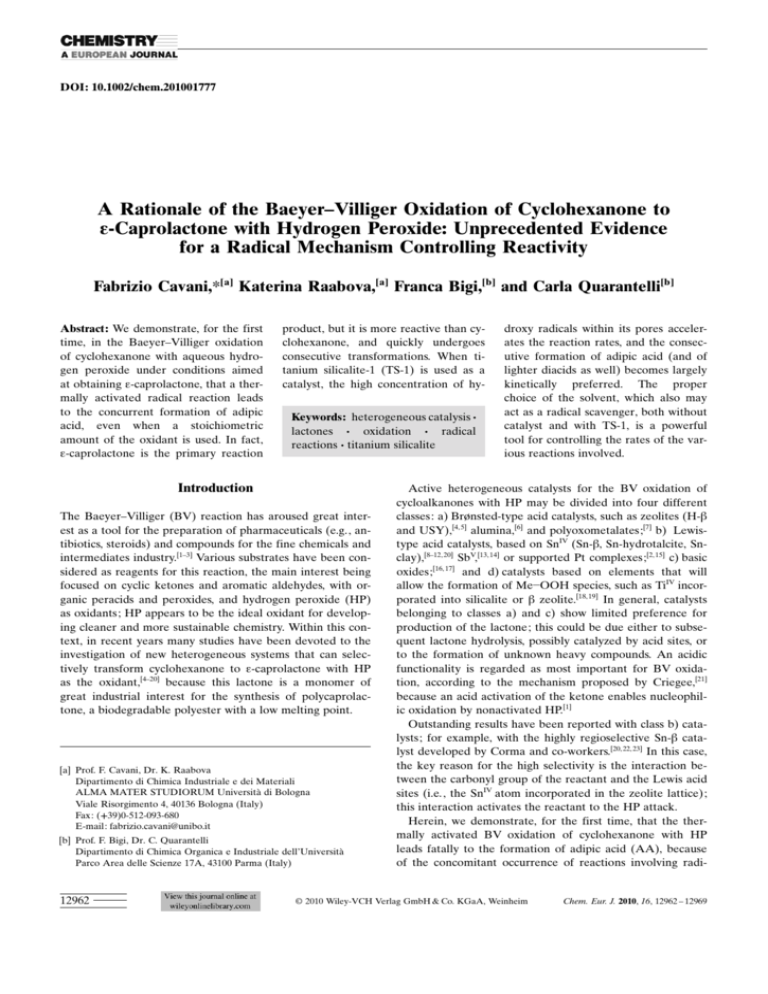
DOI: 10.1002/chem.201001777 A Rationale of the Baeyer–Villiger Oxidation of Cyclohexanone to e-Caprolactone with Hydrogen Peroxide: Unprecedented Evidence for a Radical Mechanism Controlling Reactivity Fabrizio Cavani,*[a] Katerina Raabova,[a] Franca Bigi,[b] and Carla Quarantelli[b] Abstract: We demonstrate, for the first time, in the Baeyer–Villiger oxidation of cyclohexanone with aqueous hydrogen peroxide under conditions aimed at obtaining e-caprolactone, that a thermally activated radical reaction leads to the concurrent formation of adipic acid, even when a stoichiometric amount of the oxidant is used. In fact, e-caprolactone is the primary reaction product, but it is more reactive than cyclohexanone, and quickly undergoes consecutive transformations. When titanium silicalite-1 (TS-1) is used as a catalyst, the high concentration of hyKeywords: heterogeneous catalysis · lactones · oxidation · radical reactions · titanium silicalite Introduction The Baeyer–Villiger (BV) reaction has aroused great interest as a tool for the preparation of pharmaceuticals (e.g., antibiotics, steroids) and compounds for the fine chemicals and intermediates industry.[1–3] Various substrates have been considered as reagents for this reaction, the main interest being focused on cyclic ketones and aromatic aldehydes, with organic peracids and peroxides, and hydrogen peroxide (HP) as oxidants; HP appears to be the ideal oxidant for developing cleaner and more sustainable chemistry. Within this context, in recent years many studies have been devoted to the investigation of new heterogeneous systems that can selectively transform cyclohexanone to e-caprolactone with HP as the oxidant,[4–20] because this lactone is a monomer of great industrial interest for the synthesis of polycaprolactone, a biodegradable polyester with a low melting point. [a] Prof. F. Cavani, Dr. K. Raabova Dipartimento di Chimica Industriale e dei Materiali ALMA MATER STUDIORUM Universit di Bologna Viale Risorgimento 4, 40136 Bologna (Italy) Fax: (+39)0-512-093-680 E-mail: fabrizio.cavani@unibo.it [b] Prof. F. Bigi, Dr. C. Quarantelli Dipartimento di Chimica Organica e Industriale dellUniversit Parco Area delle Scienze 17A, 43100 Parma (Italy) 12962 droxy radicals within its pores accelerates the reaction rates, and the consecutive formation of adipic acid (and of lighter diacids as well) becomes largely kinetically preferred. The proper choice of the solvent, which also may act as a radical scavenger, both without catalyst and with TS-1, is a powerful tool for controlling the rates of the various reactions involved. Active heterogeneous catalysts for the BV oxidation of cycloalkanones with HP may be divided into four different classes: a) Brønsted-type acid catalysts, such as zeolites (H-b and USY),[4, 5] alumina,[6] and polyoxometalates;[7] b) Lewistype acid catalysts, based on SnIV (Sn-b, Sn-hydrotalcite, Snclay),[8–12, 20] SbV,[13, 14] or supported Pt complexes;[2, 15] c) basic oxides;[16, 17] and d) catalysts based on elements that will allow the formation of MeOOH species, such as TiIV incorporated into silicalite or b zeolite.[18, 19] In general, catalysts belonging to classes a) and c) show limited preference for production of the lactone; this could be due either to subsequent lactone hydrolysis, possibly catalyzed by acid sites, or to the formation of unknown heavy compounds. An acidic functionality is regarded as most important for BV oxidation, according to the mechanism proposed by Criegee,[21] because an acid activation of the ketone enables nucleophilic oxidation by nonactivated HP.[1] Outstanding results have been reported with class b) catalysts; for example, with the highly regioselective Sn-b catalyst developed by Corma and co-workers.[20, 22, 23] In this case, the key reason for the high selectivity is the interaction between the carbonyl group of the reactant and the Lewis acid sites (i.e., the SnIV atom incorporated in the zeolite lattice); this interaction activates the reactant to the HP attack. Herein, we demonstrate, for the first time, that the thermally activated BV oxidation of cyclohexanone with HP leads fatally to the formation of adipic acid (AA), because of the concomitant occurrence of reactions involving radi- 2010 Wiley-VCH Verlag GmbH & Co. KGaA, Weinheim Chem. Eur. J. 2010, 16, 12962 – 12969 FULL PAPER cals formed during HP decomposition. However, strict control of reaction conditions may enable a shift in favor of the intermediate product, e-caprolactone. Even more remarkably, strong evidence was obtained that shows that the formation of lactone first, and adipic acid later, occurs through a radical mechanism, even when titanium silicalite (TS-1) is used as catalyst. Results and Discussion The thermal, uncatalyzed oxidation of cyclohexanone with HP: The results from the uncatalyzed, thermal oxidation (T = 90 8C) of cyclohexanone with HP are shown in Figure 1. This behavior, usually overlooked in studies of the catalyzed BV oxidation to lactones, indeed proved to be the key to understanding the reaction mechanism and, subsequently, the role of the catalyst and reaction medium as well. In a few hours, cyclohexanone conversion reached 40 %. e-Caprolactone was the only primary product, and was largely predominant at low cyclohexanone conversion; however, the e-caprolactone was quite reactive. Secondary products observed were 6-hydroxyhexanoic acid and AA. Note that the secondary products were not kinetically related: this means that both compounds were formed by direct transformation of e-caprolactone; the former possibly by hydrolysis, and the latter by direct oxidation. Moreover, we Figure 1. Top: Cyclohexanone conversion (~); proportional yields of capobserved that at these conditions the hydroxy acid was rolactone (&), 6-hydroxyhexanoic acid (*), 6-oxohexanoic acid (~), AA stable, and was not extensively transformed into AA. Gluta(^), and to glutaric + succinic acids ( ), all calculated with respect to ric and succinic acids were apparently formed as the final amount of cyclohexanone converted, versus reaction time, in the absence products in the reaction (the initial level of their formation of a catalyst. Reaction conditions: T = 90 8C, 1 mmol cyclohexanone (0.103 mL), 3 mmol HP (30 % aqueous solution; overall volume was nil or very low at up to 1 h reaction time), which means 0.304 mL); solvent = water (0.100 mL). Bottom: Residual HP versus reacthat these compounds were formed by subsequent reactions tion time for the tests shown in the top part (~), and for tests carried out on a secondary product, either 6-hydroxyhexanoic or adipic without cyclohexanone (&). acid. A small amount of 6-oxohexanoic acid was also formed. Reactivity tests made in the presence of radical scavengFigure 1 also shows the corresponding variation in HP ers confirmed our hypothesis (Table 1). Both cyclohexanone concentration with time for the thermally activated oxidaconversion and the product distribution were greatly affecttion of cyclohexanone, and for the decomposition of HP ed by the type and amount of radical scavenger added. First, without cyclohexanone. The decomposition of HP in the aban experiment was carried out under the same conditions as sence of cyclohexanone was only slightly less rapid than it for the tests in Figure 1, but in the presence of tert-butanol. was in the presence of cyclohexanone. This means that the The amount of tert-butanol added was in a molar ratio of presence of cyclohexanone in the solution did not have addi1:1 with cyclohexanone. We chose this compound because tional effects on HP conversion that occurred regardless of 1) it is soluble in water, 2) it generates tert-butyl hydroperthe presence of cyclohexanone. This supports the hypothesis oxide by reaction with HP, a hydroperoxide that is stable that, in the absence of catalyst (i.e., without any specific catand does not react with cyclohexanone in the absence of a alytic activation of the ketone) the formation of lactone, and then of AA, occurs by reaction with the radical species formed Table 1. Comparison of reactivity tests made without catalyst, and either with or without radical scavenger.[a] by HP decomposition. ConsidCyclohexanone Proportional yield [mol %] ering the amount of HP re- Radical 6-HHA[c] 6-OHA[d] GA + SA[e] scavenger conversion [%] AA e-CL[b] quired to produce the oxidation – 34 51 11 14 5 16 products and the HP convertert-butanol 18 51 23 9 – 17 sion, we can deduce that HP dioxane 6 18 71 – – 10 was partially (ca. 50 %) decom- [a] Reaction time = 3 h. Cyclohexanone/tert-butanol and cyclohexanone/dioxane 1:1 (molar ratios). No catalyst. posed into water and oxygen. Other conditions as in Figure 1. [b] e-CL = e-caprolactone. [c] 6-HHA: 6-hydroxyhexanoic acid. [d] 6-OHA: 6-oxohexanoic acid. [e] GA + SA: glutaric acid + succinic acid. Chem. Eur. J. 2010, 16, 12962 – 12969 2010 Wiley-VCH Verlag GmbH & Co. KGaA, Weinheim www.chemeurj.org 12963 F. Cavani et al. proper catalyst, and 3) tert-butanol may diffuse into the TS-1 pores (see experiments with TS-1 catalyst, below). After 3 h reaction time, the conversion of cyclohexanone was 18 % (versus 34 % without tert-butanol), of which 51 % (versus 51 %) was converted to AA, 23 % to caprolactone (versus 11 %), and 9 % to 6-hydroxyhexanoic acid (versus 14 %). Thus, the distribution of products was slightly different from that achieved in the absence of tert-butanol; however, the main effect was on the reaction rate at which cyclohexanone was transformed into e-caprolactone (the only primary reaction, see Figure 1), which was definitely lower than without tert-butanol. These results were confirmed by using dioxane (molar ratio dioxane/cyclohexanone = 1:1), an efficient radical scavenger that is also soluble in water.[24] In this case, the effect was even more pronounced, because the conversion of cyclohexanone was only 6 %, but with a high proportional yield (71 %) of lactone, and a low yield (18 %) of AA. Furthermore, when a large excess of dioxane was used (molar ratio dioxane/cyclohexanone 34:1, cyclohexanone/HP 1.5:1), the conversion was nil. In conclusion, these results confirm the hypothesis that the radical species formed by HP decomposition is involved in the noncatalyzed transformation of cyclohexanone into lactone and of the latter into AA. Tests made with a cyclohexanone/HP 1:1 molar ratio (stoichiometric for lactone formation) showed that even in these conditions it is possible to achieve both a remarkable cyclohexanone conversion (30 % after 6 h reaction time) and a high proportional yield of AA (see Table 2). The pro- ment in a nitrogen atmosphere. Cyclohexanone conversion after 6 h reaction time and under continuous feeding of nitrogen was 42 % (40 % in air), with 58 % proportional yield of AA (55 % in air). We could also rule out the possible role of metals present in traces in cyclohexanone for two reasons. First, the overall content of transition metals in the cyclohexanone used was less than 0.2 ppm (see Experimental Section for details). Second, we carried out reactivity tests by measuring the HP decomposition after 1 h without a catalyst at 90 8C, and by using cyclohexanone of two different purities, either 99.5 or 99.9 %. The same extent of HP decomposition was observed in each case. Experiments were also carried out by directly reacting ecaprolactone or 6-hydroxyhexanoic acid, which are postulated to be reaction intermediates in the formation of AA; the results of these experiments are reported in Table 3. The lactone was much more reactive than cyclohexanone under the Table 3. Reactivity of e-caprolactone (e-CL) and of 6-hydroxyhexanoic acid (6-HHA) without catalyst.[a] Reactant e-CL e-CL[e] 6-HHA Conversion [%] AA Proportional yield [mol %] 6-HHA[b] 6-OHA[c] GA + SA[d] 78 99 13 28 56 62 44 9 – trace trace 4 28 35 34 [a] Reaction time = 3 h, except [e]. No catalyst. Other conditions as in Figure 1 (e-CL or 6-HHA replacing cyclohexanone). [b] 6-HHA: 6-hydroxyhexanoic acid. [c] 6-OHA: 6-oxohexanoic acid. [d] GA + SA: glutaric acid + succinic acid. [e] 6 h. Table 2. Comparison of reactivity tests made without catalyst, at different cyclohexanone/HP feed ratio.[a] Cyclohexanone/HP Cyclohexanone Proportional yield [mol %] molar feed ratio conversion [%] AA e-CL 6-HHA[b] GA + SA[c] 1:3 1:1 40 30 55 43 2 7 15 37 28 13 [a] Reaction time = 6 h. No catalyst. Other conditions as in Figure 1. [b] 6-HHA: 6-hydroxyhexanoic acid. [c] GA + SA: glutaric acid + succinic acid. portion of 6-hydroxyhexanoic acid produced (37 %)was higher than that achieved with excess HP (15 %), whereas the proportion of AA produced was lower (43 % versus 55 %), as was that of the lighter diacids (13 % versus 28 %). This means that under conditions of excess HP (cyclohexanone/HP 1:3, molar ratio, as seen in Figure 1), the consecutive degradation into glutaric and succinic acids is kinetically more probable. With a cyclohexanone/HP 1:1 molar ratio, the yield with respect to the converted HP was around 75 % for an HP conversion of 87 % after 6 h reaction time (yield 80 % after 1 h, for an HP conversion of 38 %). Therefore, when the cyclohexanone/HP molar ratio was increased, the majority of the radicals generated by HP transformation reacted with the ketone. The role of molecular oxygen as a possible reactant for radical autoxidation was ruled out by carrying out an experi- 12964 www.chemeurj.org conditions examined, conversion being 78 % after 3 h, and almost complete after 6 h reaction time; this supports the view that in the uncatalyzed, thermally activated oxidation of the ketone, stopping the reaction at the formation of the lactone intermediate is not an easy task. The main product of lactone transformation was 6-hydroxyhexanoic acid; however, the latter was converted into AA, and to a minor extent to lighter diacids, when the conversion of the lactone increased. In fact, when the reaction time was increased from 3 to 6 h, conversion to AA increased from 28 to 56 %, whereas the proportional yield of 6-hydroxyhexanoic acid correspondingly decreased from 44 to 9 %. This was confirmed in an experiment carried out by direct reaction of 6hydroxyhexanoic acid (also reported in Table 3). This compound was less reactive than the lactone (conversion 13 % after 3 h reaction time); it was converted to AA (proportional yield 62 %) and to lighter diacids, with minor amounts of 6-oxohexanoic acid. All of these experiments support the proposed reaction network for the noncatalyzed, thermally activated BV reaction depicted as shown in Scheme 1. It is worth noting that, while it has been proposed in the past,[25] this is the first reported experimental evidence of the reaction network connecting the various products formed in the oxidation of cyclohexanone with HP. 2010 Wiley-VCH Verlag GmbH & Co. KGaA, Weinheim Chem. Eur. J. 2010, 16, 12962 – 12969 Baeyer–Villiger Oxidation of Cyclohexanone to e-Caprolactone FULL PAPER Lactone is then converted into various products by means of parallel reactions (Scheme 1): 1) hydrolysis to 6hydroxyhexanoic acid, which appears to be not very reactive under the chosen conditions; or 2) radical reactions to generate either AA (Scheme 3), or lighter diacids, or, to a minor extent, 6-oxohexanoic acid. Scheme 1. Reaction network of cyclohexanone oxidation with HP. Our results demonstrate that, even in the absence of a catalyst, under conditions typically used for the catalytic BV oxidation of ketones, cyclohexanone is converted to e-caprolactone. Therefore, the radicals generated by HP decomposition, as shown in Equations (1) and (2) are also involved in the cyclohexanone transformation: H2 O2 ! 2 HOC ð1Þ HOC þ H2 O2 ! H2 O þ HO2 C ð2Þ In other words, even though an acid-type activation of the ketone may accelerate the reaction, the carbonyl moiety in cyclohexanone does not need this chemical activation to react. The Criegee intermediate may indeed form either by the classical addition of HOOH, or by a two-step reaction with COH (Scheme 2). However, cyclohexanone activation by hydrogen bonding with water could also occur (also shown in Scheme 2). Scheme 2. Left: Conventional (upper route) and nonconventional radical (lower route) routes to e-caprolactone, via the common Criegee intermediate. Right: Possible carbonyl activation by water through hydrogen bonding. Reactivity tests with TS-1 catalyst: Results of experiments carried out with TS-1 catalyst are shown in Figure 2; conditions were similar to those used for the thermally activated reaction. In contrast to the experiments carried out without catalyst, there was no formation of either the 6-hydroxyhexanoic or the 6-oxohexanoic acids, and only a very low amount of e-caprolactone was formed. The main product over the entire range of cyclohexanone conversion was AA, but glutaric and succinic acids were also produced in significant quantities. The distribution of products was not affected by the conversion, thus supporting the hypothesis that AA is mainly formed by a direct, parallel reaction of cyclohexanone, or that the intermediate e-caprolactone is very efficiently transformed into AA inside the pores of the silicalite before it diffuses out into the bulk liquid phase. Figure 2 also depicts the effect of reaction time on HP conversion; the amount of unconverted HP is compared with that achieved under the same conditions but without a catalyst. The HP conversion was greatly enhanced in the presence of TS-1, but the initial proportional yield of oxygenated compounds still remained lower than 50 %. This implies that Ti sites are able to activate HP and develop the TiOOH species, but that a large part of the latter then decomposes into radical species, and then to water and oxygen. However, it is also shown that, even though the conversion of cyclohexanone increased continuously over the entire range of reaction time (0–6 h), the amount of residual HP was already very low after 1 h reaction time. At the same time, the proportional yield of AA, calculated with respect to the converted HP, increased over time. The only possible explanation for these observations is that the rate-determining step of the process is not the gen- Scheme 3. Transformation of e-caprolactone into AA through a radical mechanism. Chem. Eur. J. 2010, 16, 12962 – 12969 2010 Wiley-VCH Verlag GmbH & Co. KGaA, Weinheim www.chemeurj.org 12965 F. Cavani et al. When the reaction was carried out under the same experimental conditions as for Figure 2, but in the presence of tertbutanol (cyclohexanone/tert-butanol molar ratio 1:1), the conversion of cyclohexanone was only slightly lower than that observed during the same reaction time without tert-butanol (Figure 3). However, the main difference concerned Figure 2. Top: Cyclohexanone conversion (~); proportional yield of caprolactone (&), AA (^), and glutaric + succinic acids ( ), all calculated with respect to amount of cyclohexanone converted, versus reaction time. Reaction conditions: T = 90 8C, 1 mmol cyclohexanone (0.103 mL), 3 mmol HP (30 % aqueous solution; overall volume 0.304 mL); solvent = water (0.100 mL). Catalyst TS-1 (0.077 g; 0.032 mmol Ti). Bottom: Residual amount of HP, in the absence (~) and in the presence of TS-1 (~), and proportional yield of diacids with respect to converted HP (^), versus reaction time. eration of the TiOOH species, but its subsequent reaction with cyclohexanone; in other words, the few Ti sites (the molar ratio TiIV/cyclohexanone was equal to 0.032) act as reservoirs for the oxidizing species, the hydroxy radicals, as shown in Equations (3) to (7): H2 O2 þ OTiIV ! ðHOÞTiOOH Ð ðHOÞTiOC þ C OH ð3Þ ðHOÞTiOC þ H2 O2 ! ðHOÞTiOH þ HO2 C ð4Þ ðHOÞTiOC þ C6 H10 O ! ðHOÞTiOH þ C C6 H9 O ð5Þ C6 H10 O þ C OH ! C C6 H9 O þ H2 O ð6Þ ðHOÞTiOH þ H2 O2 ! ðHOÞTiOOH þ H2 O ð7Þ Due to both the higher reactivity of e-caprolactone than cyclohexanone, and the very high local concentration of the COH (and CO2H) radicals generated and trapped inside the TS-1 pores, lactone is very efficiently transformed into AA and lighter diacids. 12966 www.chemeurj.org Figure 3. Cyclohexanone conversion (~); proportional yield of caprolactone (&), AA (^), and glutaric + succinic acids ( ), all calculated with respect to amount of cyclohexanone converted, versus reaction time. Reaction conditions as in Figure 2, but with tert-butanol as cosolvent (cyclohexanone/tert-butanol 1:1 molar ratio). Catalyst TS-1 (0.077 g; 0.032 mmol Ti). the distribution of products. In the presence of tert-butanol, e-caprolactone formed in higher proportions; in other words, its consecutive transformation into AA was much slower than it was in the absence of tert-butanol. It is also important to note that the HP conversion over time was exactly the same for tests carried out either with or without tert-butanol; a result that agrees with the assumption that the radical scavenger does not have any effect on the HP decomposition rate. On the other hand, when a large excess of tert-butanol was used (cyclohexanone/tert-butanol 1:6), while keeping the other reaction parameters constant, the cyclohexanone conversion was largely reduced (8 % after 6 h reaction time), and once again the proportional yield of e-caprolactone was relatively high (34 versus 42 % for the proportional yield of AA). This means that tert-butanol has a major effect on the rate of oxidation of the lactone into AA, due to the higher reactivity of this compound than cyclohexanone, but when higher amounts of tert-butanol are used, the inhibitory effect also extends to the less reactive cyclohexanone. Note that the same detrimental effect was not observed when methanol was used as solvent. Furthermore, similarly to what is observed in tests carried out without catalysts, with TS-1 an experiment conducted in a nitrogen atmosphere gave the same result as that obtained in the presence of air: cyclohexanone conversion was 51 % after 3 h reaction time (versus 51 % in air), with 82 % proportional yield of AA (versus 78 % in air). Lastly, experiments were conducted by direct reaction of either e-caprolactone or 6-hydroxyhexanoic acid (Table 4); 2010 Wiley-VCH Verlag GmbH & Co. KGaA, Weinheim Chem. Eur. J. 2010, 16, 12962 – 12969 Baeyer–Villiger Oxidation of Cyclohexanone to e-Caprolactone FULL PAPER Table 4. Reactivity of e-caprolactone (e-CL) and of 6-hydroxyhexanoic acid (6-HHA) with TS-1 catalyst.[a] used in the tests shown in Figures 2 and 3; under these condiAA tions, we could not load all reactants from the very begin– e-CL 40, 0.5 93 3 2 2 – e-CL 84, 1 87 7 2 4 ning, because the very rapid dee-CL 22, 1 59 27 – 14 tert-butanol[e] composition of HP led to the – 6-HHA 17, 6 83 – 5 12 evolution of large amounts of [a] Reaction conditions as in Figure 2 (e-CL or 6-HHA replacing cyclohexanone). [b] 6-HHA: 6-hydroxyhexaoxygen, causing a sudden and noic acid. [c] 6-OHA: 6-oxohexanoic acid. [d] GA + SA: glutaric acid + succinic acid. [e] e-caprolactone/tert-buvery dangerous pressure intanol 1:1 (molar ratio). crease in the reactor. Therefore, we slowly added HP over one these tests were aimed at confirming the high reactivity of hour, and then continued the reaction over the desired time. the lactone. The reaction conducted for 1 h, under the same Because of this, the rates of transformation and extent of conditions as for cyclohexanone (Figure 2, with the same conversion of both HP and cyclohexanone were lower than molar ratio of reactant/TiIV/HP), led to 84 % lactone converthose obtained for the same reaction times in the experiments shown in Figures 2 and 3. sion, with 87 % proportional yield of AA. However, when The yield of the final solid product (which consisted of the reaction was carried out in the presence of tert-butanol, 75 % AA, and 25 % glutaric and succinic acids, with only e-caprolactone conversion was only 22 % after 1 h reaction traces of e-caprolactone; see the Experimental Section for time, with 59 % proportional yield of AA and 27 % 6-hydetails of yield measurement) was 21 % after 3 h reaction droxyhexanoic acid. This means that the presence of this altime, and 32 % after 6 h reaction time. The experiment was cohol inhibited the transformation of e-caprolactone to AA, repeated after the recovery of the spent TS-1, which was whereas the parallel route of lactone hydrolysis to 6-hydroxyeither reloaded as such for another experiment, or regenerhexanoic acid was left substantially untouched. 6-Hydroxyated either by simply washing with water and acetone, or by hexanoic acid was much less reactive than e-caprolactone, a thermal treatment at 450 8C in air for 3 h. In all cases, the which is similar to what is observed in experiments conducted without catalysts; after 6 h reaction time, conversion was isolated yield obtained after 6 h reaction time was very simionly 17 %, the main product of oxidation being AA. lar to that obtained with the fresh catalyst (results also Reactivity tests were carried out by using both greater shown in Figure 4). amounts of TS-1 and reactants and solvent volumes, to evalAgain, Figure 4 shows the results of experiments carried uate the isolated yield of AA. Figure 4 shows a plot of the out in the presence of tert-butanol. The yield after 3 h reacresults of these experiments; the yield of the products and tion time was much lower than that obtained without tertthe conversion of HP are plotted as a function of reaction butanol, but the conversion of HP did not differ in the two time for tests carried out either in water only, or in water + cases; in fact, during tests carried out with tert-butanol, most of the HP decomposed into water and oxygen. This confirms tert-butanol. During these experiments, all the reactants and the results obtained in tests carried out without a catalyst; catalyst weights loaded were 50 times higher than those the radical scavenger does not so much affect the conversion of HP, but it does affect the reaction pathway by which radicals generated by the HP conversion react further. Our results highlight that the BV oxidation of cyclohexanone, and presumably of cyclic ketones in general, indeed comprises a complex network of reactions that have often been overlooked in the literature, such as the consecutive transformation of the very reactive e-caprolactone into 6-hydroxyhexanoic acid, AA, and lighter diacids. This would suggest that it might not be possible to achieve both high conversion of cyclohexanone and high proportional yield of e-caprolactone at the same time; a result which is in contrast with most reports on the catalyzed BV oxidation of cyclohexanone with HP. Remarkably, this reaction network is the Figure 4. Isolated yield of (adipic + glutaric + succinic) acids (~,~) and same in both thermal and TS-1-catalyzed reactions, which HP conversion (&,&) as a function of reaction time. Reaction conditions: strongly suggests that the same active oxidizing species are Open symbols: 5 mL cyclohexanone, 5 mL H2O, 15.2 mL H2O2 (35 %) involved in the two cases. This supports the unprecedented (molar ratio HP/cyclohexanone 3:1). Full symbols: 5 mL cyclohexanone, 5 mL H2O, and 29 mL tert-butanol (molar ratio tert-butanol/cyclohexaview that the Ti-OOH hydroperoxo species does not act as none 6.3), 15.2 mL H2O2 (35 %) (molar ratio HP/cyclohexanone 3:1), TSan electrophile toward the activated carbonyl in the sub1 3.83 g. T = 90 8C. Isolated yield with filtered and reused TS-1 (^); isostrate, but acts as a sort of reservoir for the oxidant species lated yield with regenerated TS-1 catalyst: after regeneration of TS-1 by through the controlled decomposition of the hydroperoxo * washing with water and acetone ( ), and after regeneration of TS-1 by into hydroxy radicals. calcination at 450 8C in air for 3 h (*). Radical scavenger Reactant Chem. Eur. J. 2010, 16, 12962 – 12969 Conversion [%], t [h] Proportional yield [mol %] 6-OHA[c] GA + SA[d] 6-HHA[b] 2010 Wiley-VCH Verlag GmbH & Co. KGaA, Weinheim www.chemeurj.org 12967 F. Cavani et al. One possible explanation for discrepancies between our data and previously reported results is that the distribution of products, and therefore, the relative importance of each reaction rate in the mentioned network is dramatically affected by both the solvent used (because the solvent may act as a radical scavenger and thus slow down the consecutive transformation of the very reactive lactone) and by the characteristics of the catalyst used. For instance, we found that the Lewis-type Sn-b catalyst reported by Corma et al.[22, 23] offers unique reactivity, and that its behavior is enormously affected by reaction conditions. When we used this catalyst under conditions similar to those reported in the present work (i.e., temperature 90 8C, reaction time 3 h, 0.06 g catalyst, H2O (0.2 mL), cyclohexanone (2 mmol), HP (6 mmol)), the Sn-b afforded very low cyclohexanone conversion (0.9 %), with 20 % proportional yield of e-caprolactone and 70 % AA. However, when the same catalyst was used under conditions closer to those described in papers by Corma et al.[22, 23] (i.e., with dioxane as solvent, temperature 90 8C, reaction time 3 h, 0.06 g catalyst, 2 mmol cyclohexanone, 1.3 mmol HP, to achieve a cyclohexanone/HP molar ratio of 1.5 and a dioxane/cyclohexanone wt ratio of 30), cyclohexanone conversion was 19.4 %, with 98 % proportional yield of e-caprolactone and only 2 % AA. Conclusion In the Baeyer–Villiger oxidation of cyclohexanone with aqueous hydrogen peroxide under conditions aimed at obtaining e-caprolactone, an uncatalyzed, thermally activated radical reaction leads to the concurrent formation of adipic, succinic, and glutaric acids, even when a stoichiometric amount of the oxidant is used. e-Caprolactone is the primary reaction product, but it is more reactive than cyclohexanone, and it quickly undergoes consecutive transformations by one of two different reaction pathways: 1) a hydrolythic pathway to 6-hydroxyhexanoic acid, which also is oxidized to AA, although more slowly than the concurrent ones, or 2) a direct oxidative scission to AA. The relevant reaction rates are modified when TS-1 is used as catalyst. In this case, the high concentration of hydroxy radicals within pores accelerates the reaction rates, especially the consecutive formation of AA and of lighter diacids. The proper choice of solvent, which may also act as a radical scavenger, both without catalyst and with TS-1, is a powerful tool for controlling the rates of the various reactions involved. With either tert-butanol or dioxane, which are both efficient radical scavengers, all reaction rates are slowed down, especially the consecutive oxidation of the very reactive e-caprolactone into diacids. Experimental Section General: Titanium-silicalite-1 (TS-1) was synthesized according to a previously described procedure.[27] The structural integrity of the sample and 12968 www.chemeurj.org framework incorporation of TiIV were checked by means of XRD, FTIR, and UV/Vis diffuse reflectance spectroscopy. The amount of Ti incorporated was 2 wt %. The crystal size of this sample was < 0.2 mm. The slurry containing TS-1 crystallites was spray dried after the addition of silica Ludox, by using a Lab-Spray drier (T of nebulization chamber 200 8C, nozzle diameter 2 mm). The final average size of agglomerated particles was about 25 mm. The agglomerated samples were then calcined in air at 550 8C. Typical conditions for the thermal, uncatalyzed oxidation of cyclohexanone with HP: In a 10 mL pyrex reactor with screw stopper, a mixture of H2O (0.1 mL), H2O2 (30 %, 3 mmol, 0.340 g, 0.304 mL; source Carlo Erba), and cyclohexanone (1 mmol, 0.098 mg, 0.103 mL; sources: 1) Aldrich, code 29140, 99.5 %, containing 0.1 ppm Fe; 0.02 ppm Co; 0.02 ppm Cr; 0.02 ppm Cu; 2) Aldrich code 02482, 99.9 %) were stirred at 90 8C for the required time. The reaction mixture was then cooled to room temperature and diluted with a 1:1 mixture of H2O/ CH3CN to 50 mL. After addition of a known amount of benzoic acid as internal standard, subsequent dilutions were required to prepare samples for analysis, in particular 5 mm of internal standard for positive ion and 0.5 mm for negative ion mode. In TS-1-catalysed reactions, a mixture containing H2O, 30 % H2O2, and TS-1 (0.077 g) was stirred at room temperature for 15 min. Cyclohexanone was then added, and the mixture was heated under stirring for the required time. After cooling the reaction mixture to room temperature, the catalyst was removed by Buchner filtration, and washed with H2O (5 mL), then with CH3CN (5 mL). The filtrate was diluted with a 1:1 mixture of H2O/CH3CN (10 mL). Hydrogen peroxide conversion was determined by iodometric titration. Product concentration was determined by ultraperformance liquid chromatography (UPLC)–mass spectrometry (gas chromatography (GC) is not suitable for the identification of dicarboxylic acids.[26] Indeed, in most reports on the oxidation of cyclic ketones with hydrogen peroxide (with a few exceptions[4, 10]), the analysis of the reaction products is carried out by means of GC, which does not allow the detection of diacids.[5–9, 11–20]) UPLC analysis was performed by using an Acquity Ultra Performance Waters UPLC System equipped with autosampler. UPLC separation was conducted on a Acquity UPLC BEH C18 column (1.7 mm, 2.1 100 mm) at a flow rate of 0.3 mL min1 with an elution gradient: eluent A H2O (0.2 % HCOOH), eluent B (0.2 % HCOOH); elution: 0–2 min isocratic 100 % A, 2–10 min linear gradient to 65 % A-35 % B, 10–10.5 min linear gradient to 100 % B, 10.5–13.5 min isocratic 100 % B, 13.5–14 min linear gradient to 100 % A, 14–19 min isocratic 100 % A; flow rate 0.3 mL min1. Both the column and the autosampler were maintained at 25 8C. Mass spectrometry conditions in positive ion mode: capillary voltage 3.0 kV, cone voltage 28.0 V, source temperature 100 8C, desolvation temperature 200 8C, cone gas flow (N2) 100 L h,1 desolvation gas flow (N2) 600 L h1. Mass spectrometry conditions in negative ion mode: capillary voltage 2.8 kV, cone voltage 23.0 V, source temperature 100 8C, desolvation temperature 200 8C, cone gas flow (N2) 100 L h1, desolvation gas flow (N2) 600 L h1. Experiments focused on the determination of the isolated yield were carried out by using cyclohexanone (5 mL), H2O (5 mL), H2O2 (35 %, 15.2 mL, to give molar ratio HP/cyclohexanone 3:1), and TS-1 (3.83 g) with no tert-butanol or with 29 mL tert-butanol. In the latter case, the HP solution was slowly added over 1 h, and then the reaction was left to proceed for the desired time. Note that it was not possible to add all of the reactants at once, because the very rapid decomposition of HP leads to a sudden and very dangerous release of a large volume of oxygen. This causes a sudden pressure increase in the vessel, even when it is unsealed and exposed to air. The weight of the isolated yield was measured as follows: the hot slurry downloaded from the reactor was filtered to recover the TS-1 catalyst; then the filtrate was concentrated under vacuum at 80 8C to remove unconverted cyclohexanone and solvents (water and/or tert-butanol). The solid obtained was washed four times with cold water, dried overnight at 80 8C, and then weighed. Finally, a part of the solid was dissolved in hot water and analyzed to determine the relative amount of each product. These experiments were also aimed at determining the activity of the spent TS-1. The recovery of the spent catalyst always led to a loss of approximately 10 % of the original catalyst; the 2010 Wiley-VCH Verlag GmbH & Co. KGaA, Weinheim Chem. Eur. J. 2010, 16, 12962 – 12969 Baeyer–Villiger Oxidation of Cyclohexanone to e-Caprolactone amount lost was replaced with an analogous amount of catalyst recovered after another experiment. Then the catalyst was either reused as such, or regenerated by simply washing with water and acetone, or by washing and then by thermal treatment in air at 450 8C for 3 h. In tests for isolated yield determination, the products were also analyzed by gas-chromatography (GC). Analysis of cyclohexanone and e-caprolactone is possible by GC, but the analysis of diacids (adipic, succinic, and glutaric acids) is not; the latter need derivatization (e.g., by reaction with methanol) to be analyzable by GC.[26] The procedure for diacid derivatization was as follows: The reaction mixture was heated to 65 8C in a vacuum to remove both the unconverted cyclohexanone and the initial reaction solvent. The residual solid was mixed with an excess of methanol and BF3 (dissolved in methanol) at 80 8C for 1 h in a sealed vessel. The esters were then extracted with n-hexane (this also led to the precipitation of BF3 from the mixture); the extraction procedure was repeated several times. Lastly, the solution of diesters in n-hexane was analyzed by GC (internal standard n-decane). This method allowed the identification of acids in the form of methyl esters. Acknowledgements The ISA (Institute of Advances Studies), at the University of Bologna, is acknowledged for financial support to KR. Prof. A. Corma is gratefully acknowledged for providing the Sn-b sample. [1] R. A. Michelin, P. Sgarbossa, A. Scarso, G. Strukul, Coord. Chem. Rev. 2010, 254, 646 – 660. [2] G. Strukul, Angew. Chem. 1998, 110, 1256 – 1267; Angew. Chem. Int. Ed. 1998, 37, 1198 – 1209. [3] C. Jimenez-Sanchidrian, J. R. Ruiz, Tetrahedron 2008, 64, 2011 – 2026. [4] J. Fischer, W. Hoelderich, Appl. Catal. A 1999, 180, 435 – 443. [5] M. Lenarda, M. Da Ros, M. Casagrande, L. Storaro, R. Ganzerla, Inorg. Chim. Acta 2003, 349, 195 – 202. [6] R. A. Steffen, S. Teixeira, J. Sepulveda, R. Rinaldi, U. Schuchardt, J. Mol. Catal. A 2008, 287, 41 – 44. Chem. Eur. J. 2010, 16, 12962 – 12969 FULL PAPER [7] L. Balbinot, U. Schuchardt, C. Vera, J. Sepffllveda, Catal. Commun. 2008, 9, 1878 – 1881. [8] A. Corma, M. T. Navarro, L. Nemeth, M. Renz, Chem. Commun. 2001, 2190 – 2191. [9] Z. Lei, Q. Zhang, J. Luo, X. He, Tetrahedron Lett. 2005, 46, 3505 – 3508. [10] U. R. Pillai, E. Sahle-Demessie, J. Molec. Catal. A 2003, 191, 93 – 100. [11] C. Jimenez-Sanchidrian, J. M. Hidalgo, R. Llamas, J. R. Ruiz, Appl. Catal. A 2006, 312, 86 – 94. [12] C Li, J. Wang, Z. Yang, Z. Hu, Z. Lei, Catal. Commun. 2007, 8, 1202 – 1208. [13] A. Lambert, D. J. Macquarrie, G. Carr, J. H. Clark, New J. Chem. 2000, 24, 485 – 488. [14] C. Chen, J. Peng, B. Li, L. Wang, Catal. Lett. 2009, 131, 618 – 623. [15] C. Palazzi, F. Pinna, G. Strukul, J. Mol. Catal. A 2000, 151, 245 – 252. [16] R. Llamas, C. Jimenez-Sanchidrian, J. R. Ruiz, Tetrahedron 2007, 63, 1435 – 1439. [17] R. Llamas, C. Jimenez-Sanchidrian, J. R. Ruiz, Appl. Catal. B 2007, 72, 18 – 25. [18] A. Bhaumik, P. Kumar, R. Kumar, Catal. Lett. 1996, 40, 47 – 50. [19] M. Renz, T. Blasco, A. Corma, V. Fornes, R. Jensen, L. Nemeth, Chem. Eur. J. 2002, 8, 4708 – 4717. [20] A. Corma, L. T. Nemeth, M. Renz, S. Valencia, Nature 2001, 412, 423 – 425. [21] R. Criegee, Justus Liebigs Ann. Chem. 1948, 560, 127. [22] M. Boronat, A. Corma, M. Renz, G. Sastre, P. M. Viruela, Chem. Eur. J. 2005, 11, 6905 – 6915. [23] M. Boronat, P. Concepcion, A. Corma, M. Renz, Catal. Today 2007, 121, 39 – 44. [24] F. J. Johnston, J. Phys. Chem. 1983, 87, 1498 – 1502. [25] Y. Usui, K. Sato, Green Chem. 2003, 5, 373 – 375. [26] I. Mato, S. Surez-Luque, J. F. Huidobro, Food Res. Int. 2005, 38, 1175 – 1188. [27] M. Taramasso, G. Perego, B. Notari (Enichem), US 4410501, 1983. 2010 Wiley-VCH Verlag GmbH & Co. KGaA, Weinheim Received: June 23, 2010 Published online: September 28, 2010 www.chemeurj.org 12969
